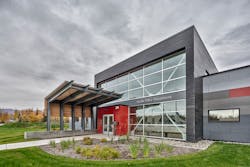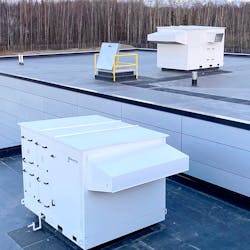Alaskan Police HQ Innovates to Upgrade IAQ, Energy Efficiency
Case Study by RenewAire
WAUNAKEE, WI, JULY 2022 -- The new, $12-million Wasilla (AK) Police Station employs many innovative HVAC designs that will save the city energy and provide occupants with unprecedented indoor air quality (IAQ).
The recently completed 20,000-sq-ft building features aesthetic, post-modern industrial architecture by Anchorage-based MCG Explore Design and doubles the size of the old police station, which had previously been a bank. The sustainable mechanical HVAC design features dedicated outdoor air systems (DOAS) with energy recovery ventilators (ERVs), hydronic radiant floor heating and packaged rooftop units (RTUs) with heat recovery that all contribute to energy efficiency.
For example, ERVs were specified without defrost coils, which are commonly used for Alaska’s frigid winters, but are costly in upfront capital, operational and maintenance costs. Instead, DN Series DOAS units manufactured by RenewAire, Waunakee, WI, use static-plate enthalpy cores. The units are designed to operate down to -10°F ambient temperatures without requiring defrost cycles, because they do not transfer H2O between supply and exhaust air. If temperatures drop lower (Wasilla temps rarely drop below -20°F), the DN-Series’ onboard controller activates a bypass damper and introduces space heat to prevent heat exchanger frost accumulation, if needed, according to Christian Dougherty, P.E., project manager at Anchorage-based consulting firm, AMC Engineers.
“The energy recovered by the DOAS units, and the fact they don’t require conventional defrost cycles and equipment, is saving the city a large amount of money,” said Dougherty, whose firm has specified core-based units on previous projects. “We’ve had mixed results in the past with energy recovery alternatives, such as enthalpy wheels, that require defrost cycles and maintenance for moving parts that cores don’t require.”
Added Jordan Privoznik, a systems sales lead for Trane in Anchorage: “Cores aren’t subject to cross contamination, which is potentially problematic in critical spaces, such as garages and evidence rooms, where contaminants can potentially infiltrate occupied spaces... DOAS units with static-plate cores are often an ideal solution in our environment as they can be more reliable than other energy recovery methodologies due to less moving parts, while still achieving very high efficiencies.”
Installed by Wasilla-based Mechanical Specialists Inc., the two DN Series ERVs provide 3,000-CFM and 1,700-CFM of 100% outdoor air in the facility’s 3,100-sq-ft garage and the 750-sq-ft evidence room, respectively. Both spaces are under negative pressure to prevent garage vehicle emissions and evidence room odors, such as bodily fluids or confiscated drug off-gassing, from infiltrating common walls shared with occupied spaces. The two units are also outfitted with sensors, an onboard controller, a manual wall switch and a smoke detector, the latter which complies with Alaska building code. The facility’s building management system (BMS), a Trane Tracer Control System, monitors the ERVs.
While evidence material off-gassing was the prime motivation, 100% outdoor air will also dilute any airborne contaminants that could degrade stored evidence. The evidence room is also closely monitored to minimize any potential degradations from wide temperature and humidity variances.
The garage’s 100% outdoor air is critical in preventing CO and NO2 accumulation and maintaining indoor air quality for employees using and servicing city vehicles. The ERV uses energy recovery to help maintain a year-round 70°F set point. On extreme cold days, which according to ASHRAE guidelines is -23°F locally, the ERV can preheat air to as high as 40°F. A 70°F leaving air temperature can be reached on extreme days by using the integral hydronic reheat coil supplied by the boiler circuit’s glycol heat exchanger.
Other project equipment includes a 25-ton, 8,500-CFM Trane Intellipak™ RTU that supplies the building and includes DX cooling, hydronic heat, and variable airflow, serving several Trane variable air volume (VAV) boxes with hydronic reheat coils to provide precise zone control. A 15-ton, 5,000-CFM Trane Voyager™ RTU was also specified. Radiant floor heating, and snow melt duties are provided by a 2-Mbh, gas-fired boiler manufactured by Riello, Mississauga, Ontario. Secondary glycol heat exchangers for air handlers were provided by Bell & Gossett, Morton Grove, IL.
Additional efficiency was created by a Dougherty and Privoznik collaboration that configured the radiant floor heating into zones (rooms) controlled by the Trane BACnet Building Automation System. While VAVs and radiant heating can operate concurrently, there exists a challenge when combining VAV technology’s quicker space comfort achievement with radiant tubing embedded in a thermal mass that takes longer to react.
“Meticulous programming and strategic commissioning were required to ensure both systems oparated seamlessly and synergistically," explained Privoznik. "This process, combined with Trane’s advanced Trim and Respond control strategies, as prescribed in ASHRAE Guideline 36, allowed us to maximize energy efficiency, maintain control stability and achieve optimal space comfort for the occupants.”
Another energy efficient design was Dougherty’s collaboration with Trane for designating one air handler for operation only during standard business hours, while the other unit operates for 24/7 occupied areas. When a large portion of the building is unoccupied, and outdoor air isn’t required, the less efficient VAV System is disabled and space temperature is maintained solely thru radiant floor heating.
Although the project didn’t apply for Leadership in Energy and Environmental Design (LEED®), Dougherty said the HVAC design would have significantly helped the building accumulate enough credits if the city had chosen certification.
Regardless, the police station is delivering 21st century comfort, IAQ and energy savings, within a strict construction budget.
##########
About RenewAire
For more than 35 years, RenewAire® has been a pioneer in improving human health, cognitive function, productivity and wellbeing by enhancing indoor air quality via energy recovery ventilation technologies. This is accomplished energy-efficiently, cost-effectively and sustainably with fifth generation static plate enthalpy core energy recovery ventilators and dedicated outdoor air systems. For more, visit www.renewaire.com, or email: [email protected].

